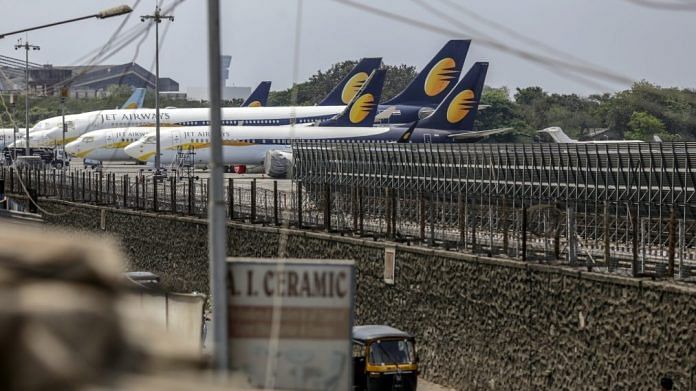New Delhi: A consortium of lenders, led by State Bank of India (SBI), has approached the Mumbai bench of the National Company Law Tribunal (NCLT) to take recourse to the Insolvency and Bankruptcy Code, 2016 (IBC) in a bid to recover their dues of over Rs 8,500 crore from Jet Airways.
The decision was taken after the lenders failed to find a buyer for the debt-ridden airlines.
With the NCLT set to begin hearing their application, ThePrint takes a look at the insolvency resolution process under the Code to understand what could transpire over the next few months.
The Code provides for a time-bound process to resolve insolvency — the situation where a company becomes incapable of repaying its debts. The idea behind IBC is implementation of a ‘rescue culture’.
The IBC places creditors in control of the company’s management and tasks it with agreeing to a ‘resolution’ plan. This plan does not involve sale, auction, recovery or liquidation of assets but to have a resolution of the debtor as a ‘going concern’. A ‘going concern’ means the business does not have any intention or need to liquidate and curtail scale of its operations.
Liquidation would be the last, unfortunate step to be taken in case a resolution plan fails to get accepted.
Also read: Not just Jet Airways, this is how India’s booming civil aviation sector went bust
Insolvency plea
The SBI-led consortium has already approached the NCLT with an application to initiate the corporate insolvency resolution process (CIRP) against Jet Airways.
For NCLT to accept this application, the consortium will have to show that there has been a default of more than Rs 1 lakh via account statements, bankers’ book certificates or any other record.
The NCLT is expected to either admit or reject the consortium’s application within 14 days. But this period of two weeks’ time to respond to a plea is not mandatory, as has been ruled by the Supreme Court.
The NCLT will hear the application against Jet Airways Thursday.
Appointment of interim resolution professional
Once an application is accepted by NCLT, the CIRP begins. The board of directors of Jet Airways will be suspended to put its management under an independent interim resolution professional, who is to be appointed by the NCLT.
The Code allows a financial creditor to propose an interim resolution professional in their application under Section 7. A financial creditor refers to lenders or anyone who has extended a debt to the corporate debtor against time value of money.
According to reports, the consortium has selected Ashish Chhawchharia of advisory firm Grant Thornton to be the interim resolution professional.
Jet Airways’ management will stop having any control of its activities, once Chhawchharia is appointed. He will collect all information relevant to Jet Airways’ financial condition.
The term of the interim resolution professional will continue till the date of appointment of a resolution professional.
Public announcement & declaration of moratorium
Immediately after the appointment of the interim resolution professional, the NCLT will direct a public announcement of CIRP, calling for submission of claims from Jet Airways’ creditors.
This will be followed by declaration of a moratorium period, which would prohibit:
- Initiation or continuation of any legal proceedings against Jet Airways
2. Transfer of its assets
3. Enforcement of security interest
4. Recovery of any property in possession of Jet Airways by an owner or lessor
However, supply of any essential goods or services to Jet Airways would not be suspended during this period. The moratorium will be in effect till the date on which the resolution process is approved or on the date of passing of an order for liquidation.
Also read: Lesson from Jet Airways crash – Save Indian capitalism from Indian capitalists
Committee of Creditors
The interim resolution professional will verify claims received through the public announcement, classify them and form a Committee of Creditors (CoC), which will assist the resolution professional in taking decisions regarding Jet Airways’ management. Voting share of every CoC member will be proportional to her or his debt share.
Appointment of resolution professional
The CoC will approve the appointment of a resolution professional with 66 per cent of its voting share. The interim resolution professional may also be appointed as the resolution professional or another resolution professional may be appointed.
The resolution professional and the CoC will together take decisions for Jet Airways with a view to maximise its assets and ensure the highest possible fair value and liquidation value.
Invitation of resolution plans
The resolution professional will thereafter issue an information memorandum, to invite prospective bidders to submit a resolution plan. The resolution plan is essentially a proposal for buying out a company undergoing CIRP as a going concern, including a mechanism for servicing or restructuring its debts. Strict eligibility criteria for resolution applicants has been laid down under the Code.
Time period for completion of CIRP
According to Section 12 of the Code, the insolvency resolution process will have to be completed within 180 days from the date of admission of an application. The NCLT can, however, extend this time limit by a maximum period of 90 days.
Approval or rejection of resolution plan
The resolution plans that are considered eligible by the CoC will be put to a vote. The plan which gets a vote share of 66 per cent of the CoC will be accepted. This will then be presented before the NCLT for its approval. The plan can be implemented after NCLT’s approval.
However, in case the CoC is unable to finalise upon a resolution plan within the stipulated time-limit (180 days or 270 days, as the case may be), or the NCLT does not approve the resolution plan presented to it on the ground that it is not in compliance with provisions of the Code, the NCLT shall pass an order for liquidation, in accordance with Section 33 of the Code.



